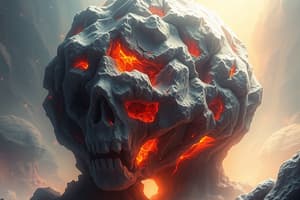Podcast
Questions and Answers
What are calcifications?
What are calcifications?
- A natural physiological process in the body
- Mineral deposits, usually calcium, in body tissues (correct)
- The aging process of body tissues
- Involuntary movements caused by neuronal disorders
In what cases can calcifications occur naturally?
In what cases can calcifications occur naturally?
- As a side effect of neuronal disorders
- During the aging process (correct)
- When induced by certain medical conditions
- As part of dystonia treatment
What is the relationship between drug-induced calcification and existing health problems like dystonia?
What is the relationship between drug-induced calcification and existing health problems like dystonia?
- Dystonia leads to calcifications which are later induced by drugs
- Drug-induced calcification is not related to existing health problems
- Drugs cure existing health problems like dystonia
- Drug-induced calcification is typically associated with existing health problems like dystonia (correct)
What do parenchymal calcifications refer to?
What do parenchymal calcifications refer to?
What is the role of the pineal gland in relation to calcifications?
What is the role of the pineal gland in relation to calcifications?
What is the major constituent involved in the calcification process?
What is the major constituent involved in the calcification process?
How can genetic mutations influence the calcification process?
How can genetic mutations influence the calcification process?
Why is understanding drug-induced calcifications important?
Why is understanding drug-induced calcifications important?
How can monitoring calcification rates in specific populations help researchers?
How can monitoring calcification rates in specific populations help researchers?
In what condition can calcified lesions impair cognitive functions?
In what condition can calcified lesions impair cognitive functions?
Flashcards are hidden until you start studying
Study Notes
Drug Endings and Calcifications
Calcifications refer to the deposit of minerals, usually calcium, in body tissues. They can occur naturally, as part of the aging process, or they can be induced by certain medical conditions or drugs. When medications affect the body's ability to control the amount of calcium absorbed and processed, calcification can result.
There are different types of calcifications, depending on their location and context. In the case of drug-induced calcification, it is typically associated with existing health problems such as neuronal disorders or dystonia, which themselves involve a loss of muscle tone and involuntary movements.
The link between calcification and medication usage highlights the interplay between medicine and the body's natural physiological processes. Understanding this relationship helps healthcare professionals tailor treatment plans while minimizing potential negative impacts on overall health.
The Process
When a drug affects the body's calcium regulation, it can lead to the formation of calcified structures called parenchymal calcifications. These can form in various parts of the brain, such as the pineal gland, which plays a role in producing melatonin and regulating sleep patterns.
In the case of the pineal gland, calcifications can originate in pinealocytes (specialized cells produced by the gland) or form within the connective tissue surrounding them. The calcification process involves the buildup of hydroxyapatite, a major constituent of bones and teeth, leading to changes in the structure and functioning of the affected tissue.
This process is influenced by multiple factors, including genetic mutations, hormones, environmental factors, and even pathogens. The misfolding of proteins, such as alpha-synuclein, can contribute to the formation of intracellular inclusions in pinealocytes, potentially causing benign mixed gliomas.
Importance
Understanding the processes behind drug-induced calcifications is crucial for developing strategies to manage and prevent these issues. By monitoring calcification rates in specific populations and analyzing how particular medications affect these rates, researchers can work towards improving the safety profiles of current treatments and designing new drugs with fewer calcification risks.
Moreover, understanding the mechanisms of calcification may help in finding ways to reverse or halt the progression of calcified lesions. This is especially relevant in treating conditions like Alzheimer's disease, where calcified lesions can impair cognitive functions.
Studying That Suits You
Use AI to generate personalized quizzes and flashcards to suit your learning preferences.




